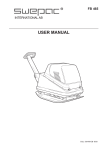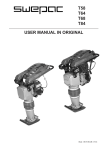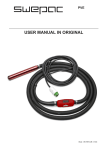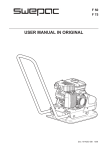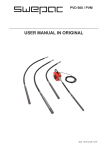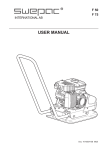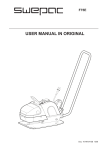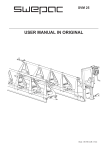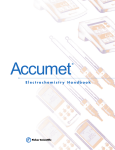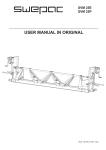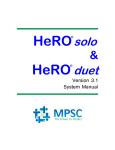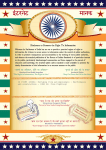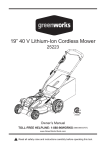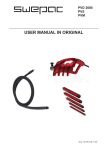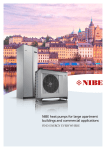Download f 80 user manual in original
Transcript
F 80 USER MANUAL IN ORIGINAL Doc: 101511-GB 1521 F 80 USE SWEPAC F 80 is used to pack gravel and sand in connection with minor construction work such as the basis for concrete blocks or paving stones for gardens. The machine’s compact design ensures good accessibility in tight spaces. CONTENTS Doc: 101511-GB 1521 USE .......................................................................... 2 SAFETY INSTRUCTIONS...................................... 3 OPERATION, PRECAUTIONS...............................3 TRANSPORT, PRECAUTIONS..............................6 MAINTENANCE, PRECAUTIONS........................6 STORAGE, PRECAUTIONS...................................6 SAFETY INSTRUCTIONS......................................7 STANDARDS . ........................................................ 7 SIGNS ...................................................................... 8 TECHNICAL DATA................................................. 9 FUNCTION.............................................................. 9 TECHNICAL DESCRIPTION............................... 10 OPERATING INSTRUCTIONS............................ 10 DAILY CHECKS.................................................... 11 BEFORE STARTING GX120 ENGINE................ 12 STARTING............................................................. 12 AFTER STARTING................................................ 12 STOPPING............................................................. 12 TRANSPORTATIONS........................................... 13 NOTES...........................................14; 15; 16; 17; 18 EC-DECLARATION OF CONFORMITY.............19 2 F 80 SAFETY INSTRUCTIONS To reduce the risk of serious injury or death to yourself or others read and understand the Safety and operating instruction before installing, operating, repairing, maintaining, or changing accessories on the machine. Post this Safety and operating instruction at work locations, provide copies to employees, and make sure that everyone reads the Safety and operating instruction before operating or servicing the machine. In addition, the operator or the operator’s employer must assess the specific risks that maybe present as a result of each use of the machine. Additional instructions for the engine can be found in the manufacturer’s engine manual. Personal precautions and qualifications Only qualified and trained persons may operate or maintain the machine. They must be physically able to handle the bulk, weight, and power of the machine. Always use your common sense and good judgement. Personal protective equipment Always use approved protective equipment. Operators and all other persons in the working area must wear protective equipment, including at a minimum: • Protective helmet • Hearing protection • Impact resistant eye protection with side protection • Respiratory protection when appropriate • Protective gloves • Proper protective boots • Appropriate work overall or similar clothing (not loose-fitting) that covers your arms and legs. Drugs, alcohol or medication Drugs, alcohol or medication may impair your judgment and powers of concentration. Poor reactions and incorrect assessments can lead to severe accidents or death. Never use the machine when you are tired or under the influence of drugs, alcohol or medication. Doc: 101511-GB 1521 No person who is under the influence of drugs,alcohol or medication may operate the machine. OPERATION, PRECAUTIONS DANGER Explosion hazard If a warm machine or exhaust pipe comes into contact with explosives, an explosion couldoccur. During operating with certain materials, sparks and ignition can occur. Explosions will lead to severe injuries or death. Never operate the machine in any explosive environment. Never use the machine near flammable materials, fumes or dust. Make sure that there are no undetected sources of gas or explosives. Avoid contact with the warm exhaust pipe or the bottom of the machine. DANGER Fire hazard If a fire starts in the machine, it can cause injury. If possible use an ABE-class powder extinguisher, other wise usea BE-type carbon dioxide fire extinguisher. DANGER Fuel hazard The fuel is flammable and fuel fumes can explode when ignited, causing serious injury or death. Protect your skin from contac twith the fuel.If fuel has penetratedtheskin, consult a qualified health professional. Never remove the filler cap, or fill the fueltank when the machine is hot. Fill thef ueltank outdoors or in aclean and well ventilated place, free from sparks and open flames. Fill the fuel tank at least ten meters (30 feet) from the place where the machine is to be used. Release the filler cap slowly to let pressure escape. Never over fill the fuel tank. Make sure the filler cap is screwed on when the machine is used. Avoid spilling fuel on the machine, wipe off any spilled fuel. Check regularly for fuel leaks. Never use the machine if it is leaking fuel. Never use the machine in the proximity of material that can generate sparks. Remove all hot or spark-generating devices before starting the machine. 3 F 80 Work in a well ventilated area. Only store fuel in a container that is specially constructed and approved for the purpose. If the machine has an exhaust, direct the exhaust so as to reduce disturbance of dustin a dust filled environment. Consumed fuel and oil containers must be taken care of and returned to the retailer. Operate and maintain the machine as recommended in the operating and safety instructions. Never use your fingers to check for fluid leaks. Wear washable or disposable protective clothes at the worksite, and shower and change in to clean clothes before leaving the work site to reduce exposure of dust and fumes to your self, other persons, cars, homes, and other areas. WARNING Unexpected movements The machine is exposed to heavy strains during operation.If the machine breaks or gets stuck, there maybe sudden and unexpected movemen that can cause injuries. Always inspect the machine prior to use. Never use the machine if you suspect that it is damaged. Make sure that the handle is clean and free of grease and oil. Keep your feet away from the machine. Never sit on the machine. Never strike or abuse the machine. Pay attention and look at what you are doing. WARNING Dust and fume hazard Dusts and /or fumes generated or dispersed when using the machine may cause serious and permanent respiratory disease, illness, or other bodily injury (forexample, silicosis or other irreversible lung disease that can be fatal, cancer, birth defects, and /or skin inflammation). Some dusts and fumes created by compaction work contain substances known to cause respiratory disease, cancer, birth defects, or other reproductive harm. Dust and fumes in the air can be invisible to the naked eye, so do not rely on eye sight to determine if there is dust or fumes are the air. To reduce the risk of exposure to dust and fumes, do all of the following: Perform site-specific risk assessment. The risk assessment should include dust and fumes created by the use of the machine and the potential for disturbing existing dust. Wear, maintain and correctly use respiratory protection as instructed by your employer and as required by occupational health and safety regulations. Ther espiratory protection must be effective for the type of substance at issue (and if applicable, approved by relevant governmental authority). 4 Avoid eating,drinking, and using tobacco products in areas where there is dust or fumes. Wash your hands and face thoroughly as soon as possible upon leaving the exposure area, and always before eating, drinking, using tobacco products, or making contact with other persons. Comply with all applicable laws and regultions, including occupational health and safety regulations. Participate in air monitoring, medical examination programs, and health and safety training programs provided by your employer or trade organizations and in accordance with occupational health and safety regulations and recommendations. Consult with physicians experienced in relevant occupational medicine. Work with your employer and trade organization to reduce dust and fume exposure at the work site and to reduce the risks. Effective health and safety programs, policies and procedures for protecting workers and others against harmful exposure to dust and fumes should be established and implemented based on advice from health and safety experts. Consult with experts. DANGER Exhaust gas hazard The exhaust gas from the machine’s combustion engine contains carbon monoxide which is poisonous, and chemicals which cause cancer, birth defects, or other reproductive harm. Inhalation of exhaust fumes can cause serious injury, illness, or death. Never inhale exhaust fumes. Ensure good ventilation (extraction of air by fan if necessary). Doc: 101511-GB 1521 Never smoke when filling the fuel tank or when working with the machine or servicing it. F 80 WARNING Projectiles Failure of the work piece, of accessories, or even of the machine itself may generate high velocity projectiles. During operating, splinters or other particles from the compacted material may become projectiles and cause personal injury by striking the operator or other persons.To reduce these risk: Use approved personal protective equipment and safety helmet, including impact resistant eye protection with side protection. Make sure that no unauthorised persons trespass into the working zone. Keep the work place free from foreign objects. WARNING Rotating blades hazards There is a risk of hands and feet getting caught by the rotating blades when the machine is running. This can cause personal injury. Never place your hands or feet inside the protection ring when the machine is running WARNING Motions hazards When using the machine to perform work-related activities, you may experience discomfort in the hands, arms, shoulders, neck, or other parts of the body. Adopt a comfortable posture whilst maintaining secure footing and avoiding awkward off-balanced postures. Changing posture during extended tasks may help avoid discomfort and fatigue. In case of persistent or recurring symptoms, consult a qualified health professional. WARNING Vibrations hazards Operate and maintain the machine as recommended in these instructions, to prevent an unnecessary increase in vibration. The following may help to reduce exposure to vibration for the operator: If the machine has vibration absorbing handles, keep them in a central position, avoid pressing the handles into the end stops. When the percussion mechanism is activated, the only body contact with the machine yous hould have are your hands on the handle or handles. Avoid any other contact, for example supporting any part of the body against the machine or leaning onto the machine trying to increase the feed force. Make sure that the machine is well-maintained and not worn out. Immediately stop working if the machine suddenly starts to vibrate strongly. Before resuming the work, find and remove the cause of the increased vibrations. Participate in health surveillance or monitoring, medical exams and training programs offered by your employer and when required by law. When working in cold conditions wear warm clothing and keep hands warm and dry. See the”Noise and vibration declaration statement”for the machine, including the declared vibration values. This information can be found at the end of these Safety and operating instructions. Doc: 101511-GB 1521 Normal and proper use of the machine exposes the operator to vibration.Regular and frequent exposure to vibration may cause, contribute to, or aggravate injury or disorders to the operator’sf ingers, hands, wrists, arms, shoulders and/or nerves and blood supply or other bodyparts, including debilitating and/or permanent injuries or disorders that may develop gradually over periods of weeks, months, or years.Such injuries or disorders may include damage to the blood circulatory system, damage to the nervous system, damage to joints, and possibly damage to other body structures. If numbness, persistent recurring discomfort, burning sensation, stiffness, throbbing, tingling, pain, clumsiness, weakened grip,whitening of the skin, or other symptoms occurat any time, when operating the machine or when not operating the machine, stop operating the machine, tell your employer and seek medical attention. Continued use of the machine after the occurrence of any such symptom may increase the risk of symptoms becoming more severe and /or permanent. 5 F 80 Never grab or touch a rotating machine part. Avoid wearing clothing, neck ware or gloves that may get caught. Cover long hair with a hair net. DANGER Electrical hazard The machine is not electrically insulated. If the machine comes in to contact with electricity, serious injuries or death may result. Never operate the machine near any electric wire or other source of electricity. Make sure that there are no concealed wires or other sources of electricity in the working area. DANGER Concealed object hazard During operating, concealed wires and pipes constitute a danger that can result in serious injury. Check the composition of the material before operating. Watch out for concealed cables and pipes for example electricity, telephone, water, gas, and sewage lines. If the machine seems to have hit a concealed object, switch off the machine immediately. Make sure that there is no danger before continuing. WARNING Involuntary start Involuntary start of the machine may cause injury. Keep your hands away from the start and stop device until you are ready to start the machine. Learn how the machine is switched off in the event of an emergency. WARNING Noise hazard High noise levels can cause permanent and disablinghearing loss and other problems such as tinnitus(ringing, buzzing, whistling, or humming in the ears). To reduce risks and prevent an unnecessary increase in noise levels: Risk assessment of these hazards and implementation of appropriate controls is essential. Operate and maintain the machine as recommended in these instructions. If the machine has a silencer, check that it is in place and in good working condition. Always use hearing protection. 6 TRANSPORT, PRECAUTIONS WARNING Loading and unloading hazard When the machine is lifted by a crane and similar appliance, this can lead to injury. Use marked lifting points. Make sure that all lifting devices are dimensioned for the weight of the machine. Never remain under or in the immediate vicinity of the machine. MAINTENANCE, PRECAUTIONS WARNING Unexpected start hazard During maintenance or when changing blades on the machine, there is a risk that the engine backfires or that the machine unexpectedly starts. This applies especially when the engine is hot and if the switch is in position ON. This can result in serious personal injury. Always let the engine cool down. Always turn the switch to position OFF. Always take the cap off the spark plug. WARNING Unexpected start hazard Any machine modification may result in bodily injuries to yourself or others. Never modify the machine. Modified machines are not covered by warranty or product liability. Always use original parts, insertion tools, and accessories. Change damaged parts immediately. Replace worn components in good time. CAUTION High temperature The machine’s engine exhaust pipe, and bottom become hot during operation. Touching them can lead to burns. Never touch a hot machine. Never touch the bottom of the machine when its hot. Wait until the engine, exhaust pipe, and bottom of the machine have cooled down before carrying out maintenance work. STORAGE, PRECAUTIONS Keep the machine in a safe place, out of the reach of children and locked up. Doc: 101511-GB 1521 WARNING Trapping hazards There is a risk of neck ware, hair, gloves, and clothes getting dragged into or caught by rotating machine parts. This may cause choking, scalping, lacerations, or death. To reduce the risk: F 80 STANDARDS Noise Measurement in accordance with the standard EN 5004 Rev. 1:1998, Annex C: Measurement uncertainty ± 0.5 dB (A) in 95% of the measurements. In accordance with the conditions in Directive 2000/14/ EC, Annex VI, the following values are reported: F 80 Sound pressure level at the operator’s ears, 90 dB (A) LpA Permitted sound power level, L WA 108 dB (A) Guaranteed sound power level, L WA 105 dB (A) As the sound pressure level at the operator’s ears exceeds 80 dB (A), ear protectors must be used during operation! Hand/arm vibrations The vibration acceleration was measured in accordance with the ISO 5349 standard during operation on a graveled surface. The measurement values were translated into the maximum daily exposure time for regular usage. For additional information about vibrations, please confer the regulation AFS 2005:15 from the Swedish Work Environment Authority, effective July 1st 2005. Measurement uncertainty ± 0.3 m/s2 in 95% of the measurements. F 80 Hand/armvibrations, m/s2 4,6 The maximum daily exposure time 2,4 h Doc: 101511-GB 1521 Exhaust emissions F 80 meet the requirements for exhaust emissions in acoordance with EU directive 2002/88 Euro2 7 F 80 SIGNS Warning signs Machine Signs 1 2 3 9 4 8 MACHINERY 5 Before use, carefully read the manual and its safety instructions so that you can handle the machine safely. Ensure that the manual is always accessible. Engine, silencer: to avoid burns or discomfort, do not touch hot engine parts when the engine is on or when the machine has recently been used. 7 1. 2. 3. 4. 5. 6. 7. 8. 9. 6 Manufacturer Place, country of manufacture. CE mark. Model name. Year of manufacture. Max. engine power. Max. weight. Serial number. Machine type As the sound pressure level at the operator’s ears exceeds 80 dB (A), ear protectors must be used when working with the machine to prevent hearing damage. 8 Doc: 101511-GB 1521 Belt drive: Keep hands, tools and other objects away from the belt drive when the machine is on to avoid injury and damage. See the safety instructions in the manual. F 80 TECHNICAL DATA FUNCTION F 80 The machine consists of a base plate with a vibration element and an upper part cushioned from the base plate. The power is transmitted from the petrol engine to the vibration element via a V-belt. The engine is fitted with an integrated centrifugal clutch. On account of the direction of rotation and the position of the vibration element at the front end of the base plate, the vibrator moves forward under its own power. The moving parts are well protected by a cover made of impact resistant ABS. Net weight..................................80 kg Base plate, w x l ........................430 x 580 mm Permitted inclination . ...............18° Speed..........................................appr 25 m/min Centrifugal force........................14 000N Vibration frequency...................93 Hz Drive engine...............................Honda GX 160 Engine power.............................4,0 kW Engine RPM...............................3600 RPM Fuel tank volume........................2,5 liter Fuel type.....................................Unleaded petrol or alkylatet FUEL AND OIL RECOMMENDATIONS Doc: 101511-GB 1521 Fuel...............................Unleaded petrol or alkylate Engine oil......................SAE10W-30 Engine oil change: first oil change after 20 hours then every 100 hours of operation 9 F 80 TECHNICAL DESCRIPTION 1 3 10 2 6 5 4 8 9 1. 2. 3. 4. 5. 6. 7. 8. 9. 10. Handle Protective cover Petrol engine Rubber damper Vibration element Base plate Engine plate V-belt Centrifugal clutch Lifting eye Doc: 101511-GB 1521 OPERATING INSTRUCTIONS The machine’s vibration elements start when the throttle is increased. The best packing is achieved at full engine RPM. Do not run the engine at other RPM except idle speed as there is a risk of clutch slipping, with abnormal wear as a result. Thanks to its compact design and low weight, the machine’sis very easy to manoeuvre. The design of the base plate allows the machine to be pulled backwards without disturbing the packed surface. The machine’s vibration element stops when the throttle is switched to idle. The machine is only designed to be used outdoors. Work with the machine in daylight or other adequate lighting. Soil must be wetted or naturally damp. All other use is discouraged. 7 10 F 80 DAILY CHECKS Fuel Check Check that there is fuel in the tank. Top up if necessary. Engine Oil Level Check Check the oil level in the crankcase every day. The oil must reach the edge of the filling hole when the machine is on a level surface. V-belt Drive Check the tension and condition of the V-belt regularly. 2 Air Filter Check The air filter must be checked at least once every working week. When working in dusty conditions, check daily. 1. Paper element 2. Foam plastic element 1 3 Adjustment of V-belt tension Loosen the screws (pos 1) that hold the engine plate. Loosen the screws (pos 2) holding the cover. Remove the cover. Cleaning the air filter 1. Remove the foam plastic element and the paper element and check that they are undamaged. Replace damaged parts. 2. Wash the foam plastic element in liquid with a high flashpoint and let it dry properly. Dip in engine oil and squeeze dry. 3. Strike the paper element against a hard object a few times to loosen any dirt. Tension the V-belt by pulling the handle on the side of the engine plate. Tighten the screws. Refit the cover. Rubber Dampers Check the condition of the rubber dampers (pos 3) regularly. Replace damaged dampers. Oil/Fuel Leakage Check every day that the engine is not leaking oil or fuel. If a leak is discovered, the machine may not be operated until the fault has been remedied. See also the separate engine instructions! 1 2 Doc: 101511-GB 1521 Polyuretan Pad A polyuretan pad is used for stone paving work to protect against stones and ground clinker. Note! Options 11 F 80 Off Oil level Off On Fuel cock On Engine power switch Active Not active Choke Full RPM Idle Throttle lever BEFORE STARTING THE ENGINE AFTER STARTING See Daily Checks on page 8. Switch the throttle lever to idle. Open the choke gradually. STARTING Run the engine warm for around 1-5 minutes. Switch the engine power switch to “on”. Open the fuel crane. STOPPING See that the lever is in idle speed position. Switch the engine to idle and let it run for a few minutes. Active the choke. If the engine is cold, active the choke completely. Do not use the choke if the engine is warm or if the air temperature is high. Switch the engine power switch to “off”. Close the fuel crane. Doc: 101511-GB 1521 Start by pulling the starting handle. Pull it first until the mechanism engages. Then pull it hard and fast. 12 F 80 TRANSPORTATION Transport locking It is easy to remove the handle without tools, and the boot of a standard car is sufficient to transport the machine. Secure the machine with straps according to illustration during transportation Note! Secure it by the base plate and not the rubbercushioned upper part. Lifting by hand Remove the handle by pushing it forward and pull apart the shafts so that the fastening tabs release. Stir the handle slightly sideways so that the handle release. Caution!The machine must be lifted by 2 persons! Lift by means of the handle on the back and the front edge of the machine. Doc: 101511-GB 1521 Lifting with crane Tilt the handle forward. Fit a lifting sling to the lifting eye and thread the lifting sling between the shafts of the handle, see illustration below. 13 Doc: 101511-GB 1521 F 80 NOTES 14 Doc: 101511-GB 1521 F 80 NOTES 15 Doc: 101511-GB 1521 F 80 NOTES 16 Doc: 101511-GB 1521 F 80 NOTES 17 Doc: 101511-GB 1521 F 80 NOTES 18 F 80 EC-declaration of conformity Manufacturer Swepac AB Blockvägen 3 34132 Ljungby 1. Category: Vibratory plate 2. Type: F80 3. Engine power: F80 4,0 kW The product complies with the following directives: 2006 / 42 / EG 2000 / 14 /EG 2004 / 108 / EG EN 500-1 EN 500-4 Technical documentation held by: Doc: 101511-GB 1521 Swepac AB, Blockvägen 3 SE-34132 Ljungby Tomas Johansson / Product Engineer 19 SWEPAC AB Address Blockvägen 3, 341 32 Ljungby, Sweden, tel. +46 (0)372-156 00, fax +46 (0)372-837 41, E-mail [email protected], Internet www.swepac.se




















